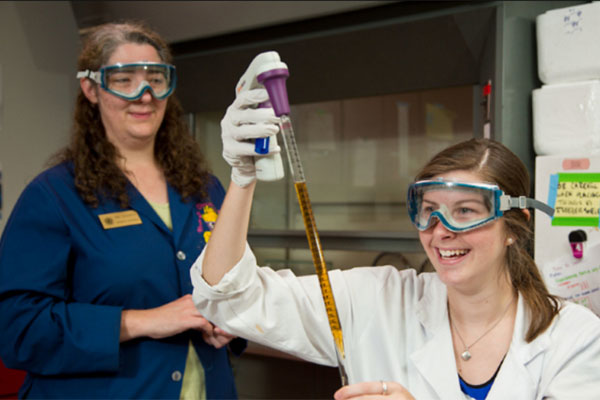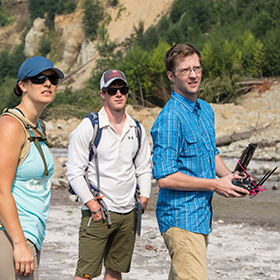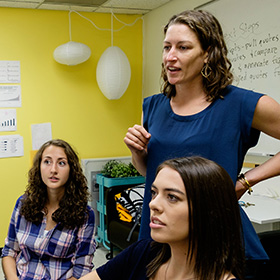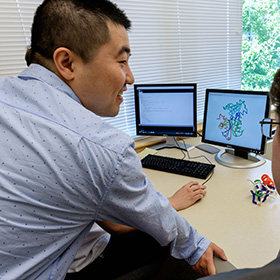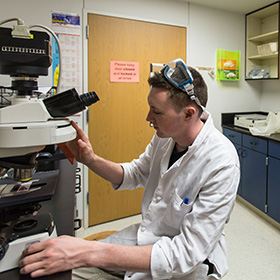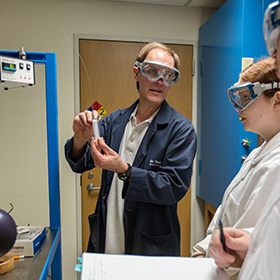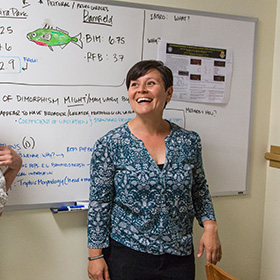“Working with undergraduates is really why I took this kind of job,” said Dean Waldow, professor of chemistry. “It’s really core to my educational philosophy, having students really get their hands on real-world problems and actually doing work.”
For some, summer is a time for play. For others, it’s a time for work. But for many at Pacific Lutheran University, it’s a time for a little bit of both — through science.
The Division of Natural Sciences at PLU offers rigorous opportunities for inquiry and discovery each summer through the Summer Undergraduate Research Program, in which students take their curiosities outside the classroom and gain valuable mentorship through professional development workshops and close collaboration with professors. This summer was no different, as 31 students assisted faculty from the biology, chemistry, computer science, geosciences, mathematics and physics departments in a variety of research endeavors. Each year, the students present their findings from the 10-week program, and collect $4,500. Here is a collection of some of this year’s participants, who were selected through a competitive application process.
Locating landslide hazards in Western Washington
Tarka Wilcox
Tarka Wilcox, assistant professor of geosciences, has traded the lab for mountain biking, cliffside rappelling and drones. Luckily for him, his two student researchers have former military experience, perfect for their treks through Western Washington.
Wilcox and geoscience majors Justin Johnsen ’18 and Samantha Denham ’18 are using high-end drones to identify potential landslide hazards in Western Washington. Research like this could help communities such as Oso, Washington, prepare for landslides. In 2014, Oso experienced one of the nation’s deadliest landslides. It claimed the lives of 43 people, devastating the community.
“It’s still so fresh in a lot of people’s memory,” Wilcox said. “And you see that when you go out to the site and people who are community members are still mourning their losses and still trying to deal with how this happened.”
The mapping that Wilcox is doing can be used by communities, emergency response units, city planners and others to help navigate the impacts and risks of a potential landslide. A lot of coordination is required to find locations to map, as drones can’t interfere with commercial airspace. It can be tricky to find locations that are high risk and within a suitable distance of an airport.
“It is a pretty rigorous site-selection process,” Wilcox said. “All the pieces need to fall into place.”
Wilcox and his team start by doing desk work to identify the sites. Then they travel to the sites and map them with the drones, before returning to the lab to pinpoint potential hazards.
Denham was an aircraft mechanic in the Air Force. She found a home in the geosciences department after returning to school from her service.
“When I started going back to school I really found a love in geology and this summer has really brought that home to me,” Denham said. “It has helped me understand that I am doing something that I really am passionate about. It doesn’t really feel like doing work when you’re doing something that you like to do.”
And the work that Wilcox, Denham and Johnsen are doing has the potential to truly help communities survive a potentially deadly natural disaster.
“It’s not just about these big-picture questions,” Wilcox said, “it’s about what can I do today to help these people tomorrow.”
Science education for an inclusive classroom
Shannon Seidel
Good teachers know that so much of what matters in the classroom is not the actual content but the conversations that build rapport and connections with students.
Shannon Seidel, assistant professor of biology, and her student researchers are studying “instructor talk;” in other words, everything an instructor says in a course that is not directly related to the content or topic of study.
“I think instructor talk is cool and important because I hear from students about how one thing their instructor said in class has changed their life or career path,” Seidel said. “If what an instructor says can have that much power, it is a variable worth considering.”
Seidel and her team, in collaboration with researchers at San Francisco University, are analyzing instructor talk throughout 60 classrooms. They hope to identify the ways instructors engage students in active learning while avoiding microaggressions, stereotypes and other potential barriers to learning.
“I’m particularly interested in it because we need more scientists and we need more diverse scientists,” Seidel said. “The research we are doing is really about creating a more inclusive classroom environment that will effectively train a broad range of people.”
Seidel’s research is focused on interdisciplinary work and her team reflects that. Courtney Hartman ’18, a biology major, and Miranda Martens ’18, a sociology major, worked with Seidel all summer.
“One of my favorite things about working at PLU is that I get to work with really interdisciplinary teams of students,” Seidel said. “Last year I had a biologist and physicist working on my project. So I really like the liberal arts and interdisciplinary nature of the work we get to do here.”
The final step is to publish their research.
“I think that the publishing piece is so exciting because being published in your undergrad is so rare,” Martens said. “It just sets me up for success in anything I apply for in the future.”
Artificial intelligence without the science fiction
Renzhi Cao
What do self-driving cars, Amazon recommendations and Google Translate all have in common?
They all utilize machine learning, a branch of artificial intelligence that starts with an algorithm and then learns and adjusts on its own. Machine learning is an integral part of the modern technology world, used by companies such as Facebook and Google — and now, Renzhi Cao’s summer research at PLU.
“We want to create a technique, where instead of telling the machine what to do, we want to give the intelligence to the machine,” Cao said.
Cao and his team are working on applying machine learning to bioinformatics. They are writing an algorithm that will take huge amounts of data on protein sequences and produce conclusions, notice patterns and speed up analysis for scientists to use. It is a little bit of biology, statistics, mathematics and computer science. One application of this research is more efficient pharmaceutical drug design.
“This is the first time at PLU that computer science has attempted this kind of research,” Cao said. “It is very new and the experience can be used for other students later.”
The research is so cutting edge that Cao and his students often reference research published by others within the workweek.
“I always recommend my students explore some new research and to use the new technique and apply that to our project,” Cao said.
For computer science major Matthew Conover ’19, this project has been stressful but rewarding.
“It’s stressful, especially when things don’t go as well as you would like, and it is a fun challenge,” Conover said.
John Smith ’19, another computer science major on the research team, said the project has been a source of pride, despite the challenges.
“I love being able to have an actual physical thing that we created,” Smith said, “and being able say that this is mine and I worked really hard on it and present it to someone.”
Biofuel for the future
Jon Freeman
One thing Christine Sohn ’19 has learned about bacteria: “It just smells so gross.”
Sohn is one of the student researchers for Jon Freeman, assistant professor of chemistry. They spent the summer studying a species of green algae whose genes can be isolated and used for biofuel production.
The team uses a fluorescent screen to identify high-producing algae strains, then puts those particular genes into an E. coli host to optimize the gene production.
“I have been interested in biofuels and the optimization of biofuels for a while,” Freeman said. “So I had this idea of trying to enhance the enzymes using this fluorescent screen and I wanted to try it out.”
This research project is a continuation of Freeman’s post-doctoral research. So far, the results have been up and down.
“Research is like a roller coaster,” he said. “Sometimes things work out and other times things don’t work out and that can be disheartening but you just have to go with the flow of it.”
Sohn, who is participating in undergraduate research at PLU for the first time, said it’s been worthwhile despite the challenges.
“I think being able to bounce back from seeing results that you weren’t expecting and trying out new procedures, I think that’s been the most exciting part,” she said. “And to be able to work with my mentor who I really admire and also work with a good friend has been a fun process.”
This research has the potential advance biofuel science and technologies, helping impact future energy consumption.
“One thing that has always impressed me about PLU is the level of research that goes on here in the summer,” Freeman said. “We are not doing small simple projects, everyone is tackling a relatively large and important goal.”
Building better batteries
Dean Waldow
“I think it’s really cool that I can go home to my parents and say I am working on improving batteries and that has an actual reaction from them,” chemistry major Katie Gardiner ’18 said.
Gardiner is one of the student researchers for Dean Waldow, professor of chemistry. She is working alongside Jacob Finney ’18 to build better, safer batteries.
Last summer she conducted research in an organic chemistry lab at PLU, which didn’t have the same relevancy for her parents.
“This is something they can understand,” she said.
Recent reports of exploding Samsung Galaxy Note 7 cellphones and personal hoverboards underscore the need for safer batteries. Waldow is interested in how to use polymers — rather than flammable electrolytes — to make safer, more efficient batteries.
“Our project is really focused on trying to make better lithium-ion batteries and understand why safety is an issue,” Waldow said, “so we can both address safety and increase capacity in batteries.”
The team is working with rigid polymers that have highly conductive regions. They are working in a lab using experimental techniques to study how the polymers organize and ions move through the polymers. The experimental techniques include, for example, electrochemistry — the branch of the discipline that deals with the relations between electrical and chemical phenomena. The work is funded by the National Science Foundation.
Finney, one of the student researchers, became interested in summer research after taking organic chemistry classes.
“I love how (research) is so different from the very structured labs. It’s very free-form,” said Finney, a chemistry major. “You run into so many more problems because it is stuff that is new. As Waldow has said, ‘if research was easy it would have already been done.’”
Studying the evolution of fish
Heidi Schutz
To Heidi Schutz, happiness looks like graphs. More specifically, finding patterns in graphs.
And this summer was full of graphs.
“Joy means you make a graph and you’ve got patterns,” she said. “There is the stuff that you hypothesized would come out and then there is the stuff that are ‘wow these are cool and exciting and this is a brand new thing.’”
Schutz, assistant professor of biology, and her two student researchers are studying populations of three-spined stickleback fish (gasterosteus aculeatus). They are about the size of an index finger and live throughout the Northern Hemisphere. They are similar to salmon, in that they live mostly in marine environments but travel to freshwater to spawn. However, there are several populations that live out their lives in rivers or lakes close to the ocean.
Their behavior, biology, and body shape or skeletons shift depending on their environment, Schutz said. These various environments are ideal for studying how the sexes evolve differently.
“This capacity for variability in sticklebacks makes them a wonderful model for studying evolutionary patterns, what drives those differences and how new species form,” Schutz said. “Just like whole populations can differ, the dimorphism that these fish exhibit within these populations can differ, too, across many different types of body structures.”
One example of such differences between males and females — based on well-documented discovery by researchers at other institutions — is that males have bigger brains in some populations while females have bigger brains in others. Brain size has been linked to offspring care — the larger the brain, the more likely that particular sex is to care for the offspring.
Schutz and her students, on the other hand, are looking for patterns in the dimorphism of the skeletons of sticklebacks. They are using both two- and three-dimensional CT scans of the fish to measure the anatomy of their fin and spinal structures, mapping different points throughout the body with digital landmarks.
Along with providing valuable knowledge on the evolution of sticklebacks, this research could be used in studying dimorphism in other species, such as salmon. It could also inform conservation strategies, since the biological differences between males and females may imply different habitat needs.
For biology major Ethan Warwick ’19, this research is an exciting opportunity.
“I am enjoying the entire process and the fact that this could actually mean something,” he said. “Hopefully (this is) my first of many contributions to the scientific community.”


